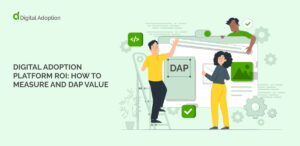A process map and a journey map can each be useful, but they each have a different use case.
In this post, we’ll learn about the difference between these two business tools, what their advantages are, and how to make the most of each one.
Process Map vs. Journey Map: Key Differences
Process maps and journey maps are clearly defined tools, so before implementing either, it is important to clearly understand those differences.
Process Maps
A process map is a visual representation of a business process.
That business process can be a simple workflow belonging to an individual employee, or it can be a complex business process being performed by multiple departments.
Processes can be mapped using several methods, including:
- Flowcharts, which use geometric shapes and lines to outline the business process
- Swim lanes, which break a business process down by the functions that contribute to it
- Value streams, which are diagrams that take a top-down perspective of business processes
There are several reasons why process maps have become standard in many organizations.
For instance, process maps:
- Allow viewers to quickly understand a business process. Process maps may be used or reviewed by a large number of people, particularly for complex processes in an enterprise setting. Therefore, it is important to create a diagram that can be understood simply by looking at it. Doing so allows viewers to quickly grasp the process, while also reducing ambiguity – a problem that can occur when using words alone to document processes.
- Can be used to analyze processes and improve upon them. Workflow and process efficiency can have a significant impact on employee productivity, organizational performance, business agility, and more. One of the key benefits of process maps is that they streamline process improvement and make it easy to optimize resources, tasks, time, money, and all other elements that are part of a process.
- Provide a common, unambiguous language that can be used to discuss processes. Since processes can be viewed by so many people, it is important to describe them in a way that anyone can understand. The use of notation systems, such as BPMN, ensures that everyone understands exactly what a process map is describing. If, on the other hand, each process map uses its own design language and terminology, process mapping can have the opposite of its intended effect – namely, it can make processes more difficult to understand, analyze, and standardize.
In short, process maps are useful from an engineering perspective. They allow managers, enterprise architects, business process managers, and other professionals to understand, analyze, and measure processes.
Journey Maps
Journey maps are used to diagram a person’s experience, such as the the experience of a customer, an employee, or an app user.
For instance, journey maps may outline:
- A customer’s pathway to purchase
- The product adoption process
- The employee life cycle
Depending on who creates them, process maps may differ in detail and scope.
Some may cover an entire user experience from beginning to end. Others, however, may only cover small segments of a journey.
Likewise, some maps may be extremely detailed, while others may be more general.
That being said, there are many elements common to many journey maps, such as:
- Clearly defined goals and objectives for each stage
- Stages for the journey laid out along a timeline
- Descriptions of the typical individual undertaking the journey
- Metrics and KPIs that can help measure the process’s performance
Journey maps can be used by a wide variety of professionals, from UI designers to marketers to product developers to employee experience managers.
Choosing Between Process Maps and Journey Maps
Asking these questions can make it easy to decide which tool to use:
- Am I designing a product, experience, or service?
- Is my map going to be used by a team of specialists?
- Does my map describe the perspective of the end recipient of the process?
Answering yes to these questions would suggest that you need a journey map. After all, journey maps are typically used by specialists to create better experiences for the end user – hence the term “journey map.”
On the other hand, if you answer yes to any of these questions, you may need a process map:
- Is my goal to understand and/or optimize a business process?
- Will this map be used or viewed by those outside of a specialized team?
- Does the map make use of a common notation or language?
- Does the map focus on the events and activities within a workflow?
Though there is some overlap between the two, choosing the right tool shouldn’t be too difficult.
The key difference between the two is this: process maps describe those performing the process, while journey maps are built around those experiencing the end result of a process.
People Also Ask
-
What if a process map becomes outdated—how often should it be reviewed?A process map should be reviewed regularly—ideally every 6–12 months or whenever key processes change—to ensure ongoing accuracy and avoid misleading guidance.
-
How does a process map support regulatory compliance?Multi‑level mapping—from macro overviews to sub‑process details—enables both strategic clarity and operational detail, aiding alignment across functions and improving stakeholder understanding.
-
Why use multiple levels (e.g., macro to detailed) in process mapping?Multi‑level mapping—from macro overviews to sub‑process details—enables both strategic clarity and operational detail, aiding alignment across functions and improving stakeholder understanding.
-
When should process mapping integrate with continuous improvement methods like PDCA?Integrate process mapping during the “Plan” stage of PDCA to document and analyze workflows before testing changes—a proven approach in quality and lean improvement cycles.

 FACT CHECKED
FACT CHECKED







